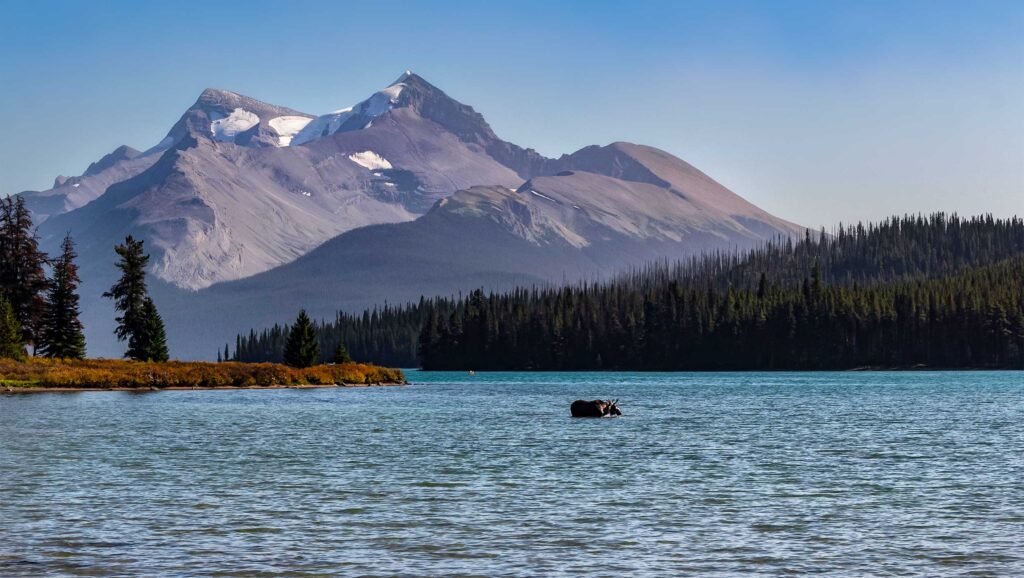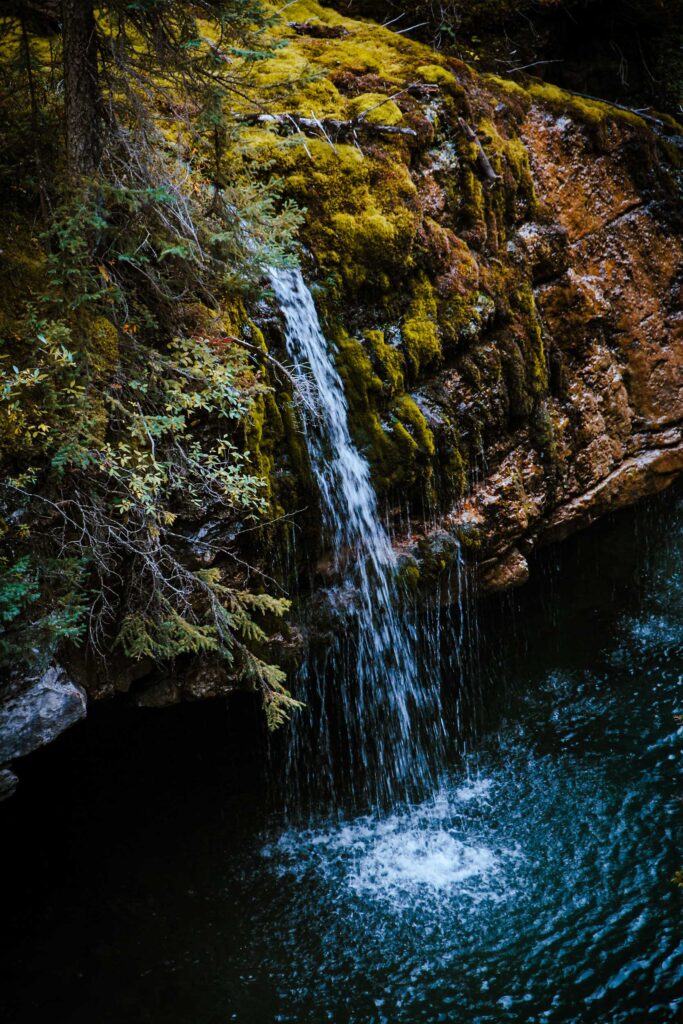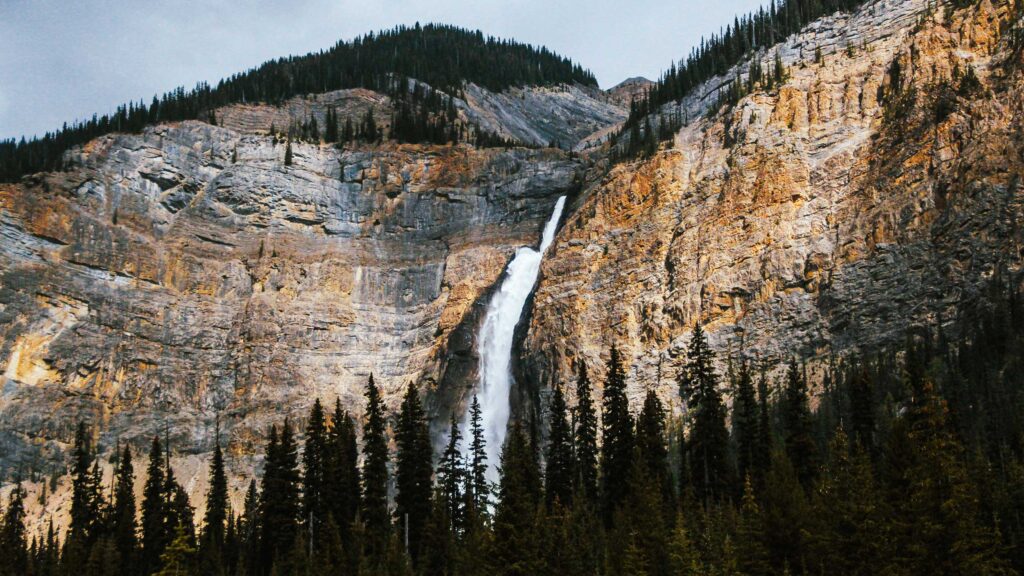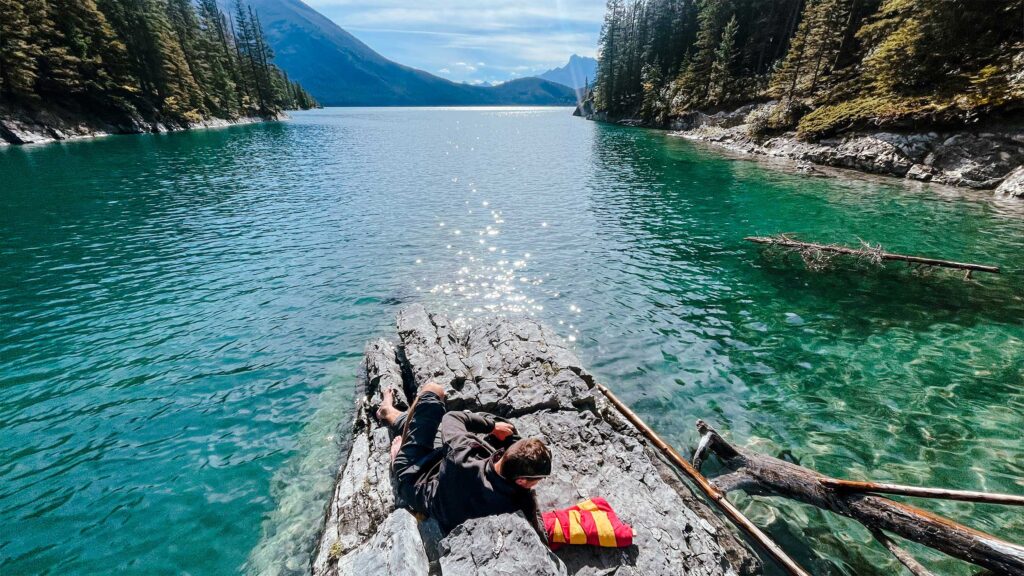The Canadian Rockies are such an amazing and unique place with so many outdoor activities. It’s almost impossible not to spot wildlife, but if it comes to traveling you may find planning a trip quite overwhelming. That’s why I made this Rockies road trip itinerary and tried to put together all the things you need to know before you go.
TABLE OF CONTENT
- The best time to visit the Rockies
- Annual Discovery pass
- Check for area closures and wildfires
- Where to stay
- What to pack
- Itinerary Overview
- Must-see places
- Detailed Canadian Rockies itinerary
The best time to visit the Rockies
Definitely summer! but… if you don’t mind crowds.
Winter is another experience, it’s beautiful, but it’s super cold.
Spring and fall is the ideal time for me overall. Even though the weather is more unpredictable, you can expect fewer people around.

Annual Discovery Pass
To enter the parks you will either need to buy a single-location pass in person or the Annual Discovery Pass. The second option is the best since a single pass would cost you around $10 per person for a day.
Price: $72.25 per person or $145.25 per vehicle (up to 7 people)
Valid for: 12 months
Pro-tip: If you are a newcomer or new citizen you get free admission.
Check all the area closures
Sometimes you can bump into an unpredictable situation, like the place you were planning to visit is suddenly closed. That happened to us and we had to change the plans at the last minute. That’s why it’s good to check any area closures around.
Mt Robson Provincial park
Jasper
Banff
Yoho
Kootenay
Glacier National Park
Mount Revelstoke
Check for the wildfire
Wildfires are really common in Canada, so I recommend you also check the Current Wildfire Situation for British Columbia and Alberta.

Where to stay
Choosing the places to oversleep is probably one of the biggest deals on the Canadian Rockies road trip. Here are the types of accommodation you can expect in the Rockies with average prices:
- campsites ($20)
- hostels ($70)
- Airbnb/ VRBO ($200)
- hotels ($300 – $500)
Most of the people sleep in campgrounds, but they also get booked really fast. You can book a campground in the park on the official government website.
There is an app called WikiCamps which has the largest database of campgrounds with information on costs and amenities. If you prefer not to book your campsite in advance, there are also some walk-in camps as well.
If you are looking for more detailed information about camping, I found a really good guide.

PRO-TIP: Don’t plan your trip too tight. There are always gonna be some places on the way you didn’t know about before and would like to spend some time there. Or you could feel exhausted after a full-day hike you didn’t expect you will be. Have at least one day for resting or getting around unplanned spots.
What to pack
Necessary
- daypack
- sunscreen
- mosquito repellent
- rain jacket
- sunglasses or a hat
- discovery pass
- 2 shoes (at least one waterproof)
- warm clothes
- water bottle
- snacks
- food – long-lasting
- cooking stuff
- tent
- winter hat + coat + gloves (if you plan to go after summer)
Nice to have
- playlist + podcasts
- headlamp
- hammock
- tripod + camera
- bear spray
- laptop
- trekking poles
- Merino wool layers
- wool socks

Itinerary Overview
Here is an itinerary I prepared for our trip:
Day 1: Drive from Vancouver to Mt Robson
Day 2: Jasper, Maligne Lake, Angel Glacier, Athabasca falls
Day 3: Columbia Icefield, Parker Ridge, Mistaya Canyon Trailhead loop, Peyto Lake, Bow Lake
Day 4: Lake O’Hara
Day 5: Natural Bridge, Emerald Lake, Takakkaw falls
Day 6: Lake Louise + Lake Agnes Trail or Plain of Six Glaciers
Day 7: Moraine Lake, Sentinel Pass
Day 8: Floe Lake
Day 9: Banff (Cave & Basin, Surprise Corner, Banff upper hot springs), Lake Minnewanka
Day 10: Mist mountain – hot springs
Days 11 – 12: Drive from Banff to Vancouver
And here is what we really did:
Day 1: Drove from Vancouver to Mt Robson
Day 2: Jasper, Maligne lake, Maligne canyon & picnic at Anette Lake
Day 3: Pyramid Lake, Angel Glacier, Athabasca falls, went back to Jasper
Day 4: Icefields Parkway – Sunwapata falls, Athabasca glacier, Mistaya Canyon, Peyto lake, Bow lake, Lake Louise
Day 5: Moraine lake, Calgary
Day 6: Canmore, Banff (Tunel Mountain Trail and walking in the town)
Day 7: Takkakaw falls, Emerald Lake, Natural Bridge
Day 8: Lake Louise – Plain of Six Glaciers trail & Lake Agnes trail
Day 9: Lake Minnewanka
Day 10: Lake O’Hara, hot springs in Banff
Day 11: Consolation Lakes, Lake Moraine, Revelstoke
Day 12: 3 Valley Gap – Ghost Town, drove back to Vancouver

Must-see places
Whatever are your preferences and plans, as a first-time visitor I think you shouldn’t skip these must-see places:
- Emperor Falls
- Maligne lake + Spirit Island
- Angel Glacier
- Athabasca Glacier
- Peyto Lake
- Bow Lake
- Emerald Lake
- Lake Louise + Six Glaciers or Lake Agnes
- Moraine Lake + Consolation Lakes
- Banff

A detailed Canadian Rockies road trip itinerary
Day 1: Vancouver to Mt Robson
Driving time: 9 hours
I know, driving from Vancouver all the way to the Rockies within one day would be tiring. That’s why we started driving the night before a day we were planning to start our road trip to save some time and split the driving time. We left Vancouver the night before and overslept in Pemberton.
We woke up early in the morning and hit the road towards Mt Robson. We drove through Lillooet, Savona, and Kamloops and ended up in the village of Mt Robson. There are many nice places on the way you can stop, so even if the driving it’s gonna be long, don’t rush and enjoy the surroundings.

Day 2: Jasper, Maligne lake & canyon
Driving time: 1 hour (from Mt Robson to Jasper)
There are so many nice places to visit in Mt Robson Provincial Park (we wanted to go hike to Emperor Falls, but we had to skip it since the trail was closed), we decided to drive to Jasper to see the town a little bit.

MALIGNE LAKE
Driving time: 1h from Jasper
The first stop was a spectacular Maligne Lake. It has two parking lots, a restaurant, and a dock for cruises. There is no lake loop trail, but you can paddle around the lake or take a boat to Spirit Island. There are also some harder or easier hikes from Maligne Lake with a view of the lake. We decided to spend some more time here since the driving was long and staying at one place for longer just felt so rewarding.

What to do on Maligne Lake
Maligne Lake Cruise to Spirit Island
Length: 1.5 hours
Cost: $72
Maline lake boat rentals
Canoe – $80/hour
Single Kayak – $65/hour
Double Kayak – $80/hour
Maligne Lake viewpoint
moderate hike
Length: 6km
Skyline Trail: Maligne lake to Watchtower
hard hike
Length: 31km
MALIGNE CANYON & ANETTE LAKE
Driving time: 40min from Maligne Lake to Maligne canyon & Anette Lake
From Maligne Lake, you can head back toward Jasper. On the way, there is a Maligne Canyon, which I didn’t pay attention to when I was planning the trip. So we stopped there and spent around an hour. Before the sun went down and we got hungry we made a small picnic at a closeby Anette Lake.


Day 3: Pyramid Lake, Angel Glacier & Athabasca falls
Our original plan was to drive on Icefield Parkway road to Lake Louise, but since we spent some more time at Maligne Lake, we decided to stay in Jasper National Park longer. And I’m really glad we did.
We had such a spectacular morning at Pyramid Lake and its small island while watching the sunrise. By doing this we not only had a beautiful morning but got up early so we could enjoy more things during the day.

ANGEL GLACIER
Driving time: 40 min from Jasper
This trail was seriously one of the best from the whole road trip. There is a parking lot really close to the Angel Glacier which is the highlight of the whole hike, so if you don’t want to take the whole hike, you can just walk a few minutes from the parking lot to see the glacier and a lake. It’s spectacular!
Edith Cavell Meadows
moderate trail
Length: 8km
Edith Ridge Summit
hard trail
Length: 9km
There are also other longer hikes, just search for Edith Cavell.

ATHABASCA FALLS
Driving time: 45min from Angel Glacier
We wanted to leave Jasper and head down to Lake Louise and oversleep in a campground on the way. Unfortunately, at that time, there was a wildfire, the city was without power and all the campgrounds around were closed. Going towards Athabasca falls, we were still hoping we could find some camp on the way. As soon as we found out there is no place to sleep we returned back to Jasper and overslept there. It took us just half an hour and at least we had a nice dinner in the town.
If you will be heading down to Lake Louise, definitely stop at Athabasca falls, it’s really worth it.

Day 4: Icefields Parkway
Icefields Parkway is the name of the famous highway and it was rated as one of the top drives in the world. It starts in Jasper and goes all the way to Lake Louise. It has spectacular views and so many places to stop on the way. We were not lucky enough to see all those fantastic views because of the wildfires. But you can’t plan this, so we enjoyed at least what we had. We stopped at Sunwapta falls, but there are many more places on the way, like Stutfield Glacier Viewpoint, Tangle Creek Falls, or Columbia Icefield Skywalk ($35).

ATHABASCA GLACIER
Driving time: 75min from Jasper
This is probably the most famous glacier in the Canadian Rockies. It’s an ancient glacier and it currently loses a depth of about 5 meters every year because of global warming. You can see the signs marking spots where the glacier was every 5 years dating back to the 70s. It’s not recommended to walk behind the marked area because of the hidden crevasses, but it’s possible to walk on the glacier without a tour.
How to get to the glacier
Walk from a parking lot
Time: up to 15 min
Cost: free
Columbia Icefield Glacier Adventure
Time: up to 3 hours
Cost: $93

PEYTO LAKE
Driving time: 1 hour from Athabasca glacier
One of the most beautiful views! There is a big parking lot close to Peyto lake and to see the lake you will need to walk just 10 minutes to the upper viewpoint. Don’t forget to stop also at The Big Bend.

BOW LAKE
Driving time: 5min from Peyto Lake
The Bow Lake is right next to the road and you can take a hike to see the view from up. I was planning to take this hike just to get up enough to have a nice view, but it was already too late and thanks to the smoky weather, there was no point to take any hike just for views.

Pro-tip: don’t rush on this road and spend there more than one day if you can. We did it within one day because of the smokiness those days.
What else you can do or see on the Icefield Parkway
- Icefield skywalk – I wanted to give it a try because I thought walking on the glass-floor skywalk would be a nice experience, but we just passed by. First of all, because of the fires and also, it’s so small and for the money ($35) it wasn’t really worth it.
- Wilcox Pass Trailhead
- Parker Ridge Trail to Saskatchewan Glacier
- Glacier Lake Trail
- Mount Jimmy Simpson trial from Bow Lake
After visiting Bow Lake, we started heading to Lake Louise. You need to pay for parking $12.25 per day. Since it was already dark we decided to get into Fairmont Hotel. Usually, just guests are allowed to walk around, but we could manage to sneak in and man… it was beautiful.
Day 5 – Calgary
Driving time: 2 hours 30 min from Moraine Lake to Calgary
The plan for this day was totally different, but the rainy weather took over the smoky weather. So after visiting the famous Moraine Lake in the rain, we decided to leave the mountains and explore Calgary.

We were not super lucky there either. Rodeo games in Stampede park were already out of season, the famous Heritage Park was closed as well as the National Music Centre so we spent some time in a small and lovely Prince’s Island Park. Then we went to check out the Wonderland Sculpture. Calgary is also known for its artistic downtown and many quite interesting sculptures. Other than that, I feel like there is not much to see in the downtown area.
Definitely, the biggest highlight from Calgary for us was The Military museum located south of downtown. It’s the second-largest military museum in Canada. Unfortunately, we wasted a lot of time in the city and we didn’t have enough time to enjoy the exhibition. It’s recommended to spend at least 2 hours there we made it 20 min before closing.

After the museum, we headed back, overslept at Canmore, and were hoping for better weather for the next day.
Drive time: 90min from Calgary to Canmore
Day 6 – Canmore & Banff
CANMORE
After we woke up, the weather was still quite cloudy, so we just walked around the town in the morning and drove to Banff. There is not much to do in Canmore unless you want to stroll down 8th street, visit the North West Mounted Police Barracks or walk the Policeman’s Creek Trail.

BANFF
Driving time: 20 min from Canmore to Banff
As soon as we arrived in Banff we hit the Tunel Mountain Trail for the town’s view. It’s a moderate trail and it takes less than 2 hours. We headed to the town center and parked close to the train station. Here are some free parking spots in the town. We decided to walk to Vermilion Lakes from the town. It’s quite close, but you can also drive there.
Then we walked around the town and couldn’t skip a beer at Banff Ave Brewing Co.

What else you can do in Banff
- Cave and Basin (up to 1h) – the first national park in Canada with thermal springs in a cave
- Surprise corner
- Sundance Canyon
- Banff upper hot springs ($8)
To be honest, I would easily skip these two days and went for any of the hikes we planned before. We took it easy because of the rainy weather.
Day 7 – Takkakaw falls & Emerald Lake
Driving time: 1 hour from Banff
TAKAKKAW FALLS
So what we did this day was that we returned back to the direction of Lake Lousie and visited the falls. From the parking lot, it’s just a short walk to the falls. We took some photos, then it started raining and we returned back to the car.

EMERALD LAKE
Driving time: 45 min from Takkakaw falls
The plan was to arrive at the lake take some photos and leave. But Emerald Lake is actually one of the prettiest lakes I’ve visited in the Rockies. So we decided to take a loop around the lake and have no regrets. It takes around 90 min to complete and make sure you don’t take white shoes (as I did) the path could be quite muddy and slippery.

Day 8 – Plain of Six Glaciers & Lake Agnes
This was one of the most exhausting days of the whole trip. We were planning to hike just Plain of Six Glaciers which takes around 5 hours. The starting point is from Lake Louise and slowly ascends to a lovely Tea house at the almost end of the trail. The Tea house has old architecture and would be a shame not to stop there. We sit on a small wooden terrace and enjoyed a warm tea while listening to a mass of snow falling down the mountainside. Make sure you continue to the viewpoint of the six glaciers, it’s a spectacular view.

When we were going back down we decided to head up to Lake Agnes, since we had some more time. The trail from Six Glaciers to Lake Agnes is a bit steeper so make sure you have some energy left to get on the top. Don’t worry you will get rewarded with an amazing view of Lake Louise from the very top and on the other side a view of Lake Agnes. From there, it’s just a short walk down to the lake and its charming Tea house. When we got there, the tea house was already closed and we were rushing back to Lake Louise – it was getting dark.

You don’t have to do both trails, but we just felt it would be a pity if we didn’t do that. I definitely recommend you get up earlier so you don’t have to rush.
Lake Agnes Trail + Tea house
moderate trail
Length: 7,4 km
Average time: 3h
Plain of Six Glaciers + Tea house
moderate trail
Length: 14,6 km
Average time: 5h
Day 9 – Lake Minnewanka
After the previous tiring day, we decided the take it easy and spend a nice day on Lake Minnewanka. We made a picnic, relaxed on the beach and finally enjoyed the sunny day which we were waiting for. I was actually surprised at how many weddings we saw in one day. You can also stay there for stargazing.

Day 10 – Lake O’Hara
Another full-day hiking. Lake O’Hara is definitely one of the most spectacular lakes in the Rockies and pretty busy as well. However, when we were there in September, we met just a few people on the trail.
There are two ways to get there – by bus or walking. To get on the bus is a bit harder, for the peak season nearly impossible. You have to make a reservation, usually, between March 1, and March 30. The system works on the random draw and notifies you when you are chosen. The one-way ticket costs $10.

For walking up you don’t have to have a permit, just get ready for an 11 km walk on a pretty flat road.
Once you get there, you have several options for hikes:
Wiwaxay Gap
hard trail
Length: 7 km
Average time: 3 hours
Alpine Circuit
moderate trail
Length: 11 km
Average time: 5 hours
Shoreline Trail
easy trail
Length: 3 km
Average time: 45 min
Opabin Plateau and Lake O’Hara
moderate trail
Length: 8,7 km
Average time: 3 hours
Day 11 – Moraine Lake & Revelstoke
MORAINE LAKE
Our last day in the Rockies was the second and the last try to see Moraine Lake without rainy weather. No success. But, the view was still awesome.
To get to the famous viewpoint, called Rockpile, to see a well-known picture from the Canadian twenty dollar bill, you need to walk up on a huge pile of rocks and wait for your time to take photos among many other people. But first, you need to know how, or better, when to get there.

During the peak season, it’s literally a fight for a spot in a parking lot. You need to arrive at least around 4 am to get a spot at the parking lot. If they don’t let you go you can try to tell them you are going to Temple peak or any multi-day hike. It’s worth giving it a try. In September, it was enough to arrive at some reasonable time, the parking lot wasn’t full at all.
There are many hikes that start from Moraine Lake. We did at least a short one to Consolation Lakes and I can tell you, it was a nice surprise. The hike is flat and it takes 2 hours to get to and from the lakes.
You can also walk around the lake which will take approximately 45 minutes.

But if you are up to something more challenging, here are some longer hikes:
Larch Valley Trail
moderate trail
Length: 4,5 km
Average time: 1-2 hours one way
Eiffel Lake Trail
moderate trail
Length: 5,6 km
Average time: 2-3 hours one way
Sentinel Pass
hard trail
Length: 8,7 km
Average time: 3 hours one way
Paradise Valley from Sentinel Pass
hard trail
Length: 17 km
Average time: 7-8 hours
REVELSTOKE
Driving time: 2 hours 30 min from Lake Louise
It was already time to leave the Rockies behind us and start heading back to Vancouver. But another nice surprise was this lovely historic city known for ski jumping and railway. You don’t really have to stop there, but if you have time I would recommend you to do so. We spend a night there, but you can just stop by and visit Revelstoke Railway Museum. They have a giant locomotive inside.

Day 12 – Back in Vancouver
We thought this day would be just about driving, but shortly after Revelstoke, we found a 3 Valley Gap Heritage Ghost Town and we spent there literally 3 hours. It’s a small historic town accessible for a $16 fee and they have everything you could imagine an old town from a western movie would have. There is a sheriff’s office & jail, a bar with a salon, a post office, stores, a barber shop, a hotel, an old cars exposition, and even a huge railway roundhouse with train cars you can get in. It’s insane how many things are there to see and just a short stop is not enough.

After that, we finally started heading back to Vancouver and it took us around 6 hours. We arrived later than we planned, but it was definitely worth it.
Final thoughts
There are so many ways how to plan a road trip and this is just an example of how it can be done and how we made it. If I wanted to have a perfect road trip in the Rockies, I would skip a day spent on lake Minnewanka and Calgary, shorten the time in Banff and Canmore and I would’ve done more hikes, like Sentinel Pass or hike lake Floe, and would go south from Canmore.



